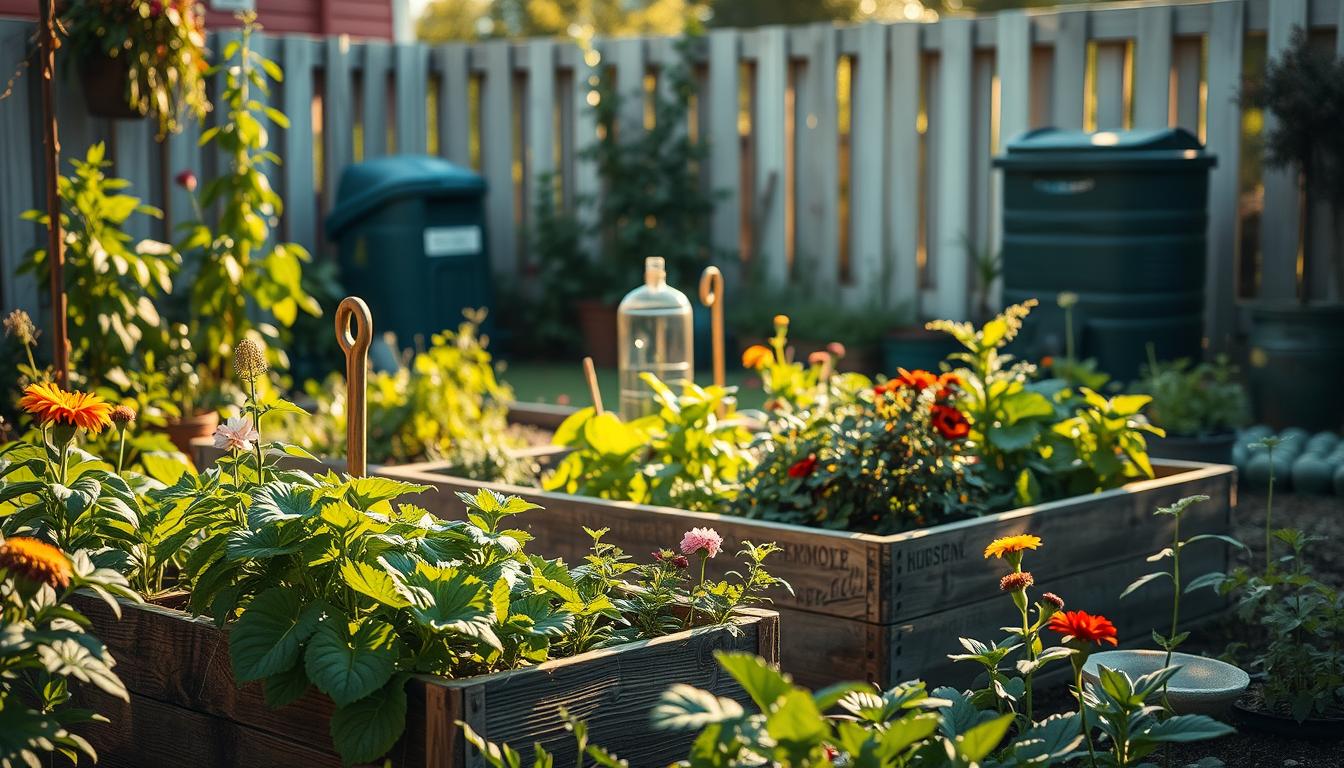Your home should be a safe haven, not a place for unwanted guests. When pests enter our homes, they pose serious health threats to our families. They can trigger asthma and cause foodborne illnesses, affecting more than just our comfort.
Today’s homeowners face big challenges in keeping their homes healthy. The bright side? You don’t need harsh chemicals or drastic steps to keep your home safe. Sustainable methods like Integrated Pest Management offer effective ways to protect your family and the planet.
This guide will show you how to make your home safer with smart prevention. We’ll talk about how to spot pests, use natural repellents, and when to get professional help. By acting now, you can lessen future problems and live in harmony with nature.
The Hidden Dangers Lurking in Your Home
Behind your walls and beneath your floors, unwanted guests might be hiding. These guests include tiny insects and larger mammals. They can harm your home. Knowing about these pests is key to keeping your home safe.
Common Household Pests in American Homes
American homes are perfect for pests looking for food, water, and shelter. These pests often hide until their numbers become a problem.
Insects and Arachnids
Ants are common pests in kitchens, looking for food and sweets. Cockroaches live in dark, damp places and breed fast.
Bed bugs hide in mattresses and furniture, feeding on people while they sleep. Some spiders can bite painfully or even be dangerous.
Rodents and Larger Pests
Mice and rats sneak into homes through small openings. They make nests in walls, attics, and crawl spaces. They can spread diseases and damage your home.
In suburbs and rural areas, raccoons and squirrels might live in attics or chimneys. They can damage insulation, wiring, and your home’s structure.
Health Threats Posed by Household Pests
Pests are not just annoying; they can also be very harmful to your health. They can cause short-term and long-term health problems.
Disease Transmission Pathways
Pests can spread diseases in many ways. Touching them or their waste can expose you to harmful germs. Their droppings can also contaminate surfaces and food.
Rodents can carry hantavirus, salmonellosis, and leptospirosis. Cockroaches can spread food poisoning bacteria. Ticks and mosquitoes can give you Lyme disease and West Nile virus.
Allergies and Respiratory Issues
Many pests can make breathing hard. Dust mites, tiny spiders, feed on human skin and cause allergies. Cockroach waste is a common asthma trigger in cities.
Mouse dander and urine can also cause allergies and make breathing worse.
| Pest Type | Common Examples | Primary Health Risks | Warning Signs |
|---|---|---|---|
| Insects | Cockroaches, Ants, Bed Bugs | Asthma triggers, Food contamination, Skin irritation | Droppings, Cast skins, Unusual odors |
| Arachnids | Spiders, Dust Mites, Ticks | Venomous bites, Allergic reactions, Disease transmission | Webs, Bite marks, Respiratory symptoms |
| Rodents | Mice, Rats | Hantavirus, Salmonellosis, Structural damage | Droppings, Gnaw marks, Scratching sounds |
| Larger Mammals | Raccoons, Squirrels | Rabies, Property damage, Secondary infestations | Thumping noises, Damaged entry points, Nesting materials |
Why Pest and Disease Control Is Essential for Family Safety
Pest and disease control is more than just keeping your home clean. It’s about keeping your family safe and your home’s value high. Good pest management keeps your home and family healthy. It’s a key part of taking care of your home.
Protecting Vulnerable Family Members
Children, the elderly, and pets are at higher risk from pests. Their immune systems are weaker, making them more likely to get sick from pests.
Poor pest control can lead to serious health problems. These include:
- Respiratory issues from cockroach allergens and rodent dander
- Skin irritations and infections from bed bug bites
- Disease transmission through tick and mosquito bites
- Potential poisoning from pest droppings contaminating surfaces
Even small pest problems can be big health risks for vulnerable family members. Keeping pests under control is crucial for their safety.
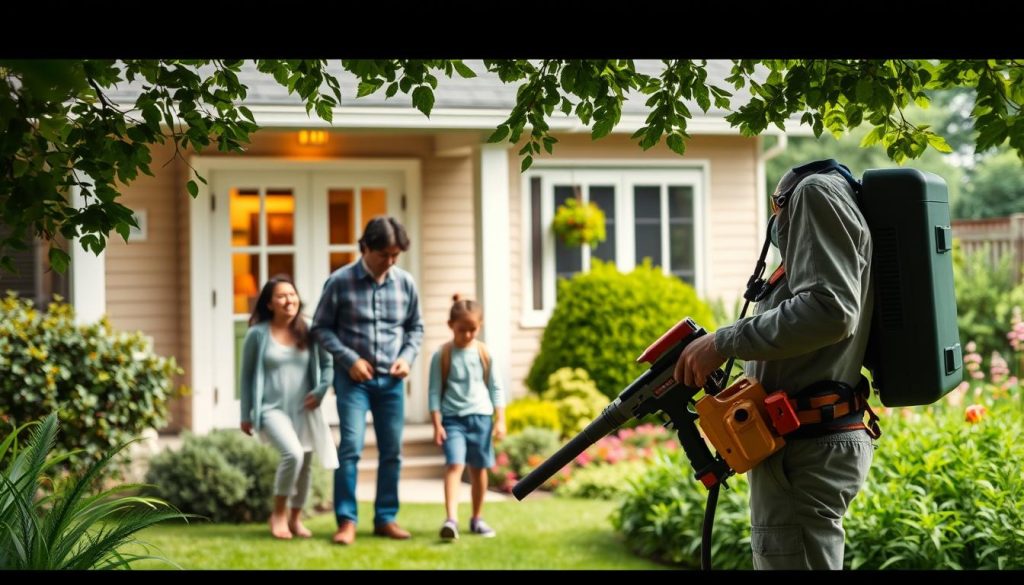
Preventing Structural Damage to Your Property
Pests can quietly damage your home. Termites alone cause over $5 billion in damage each year in the U.S. Often, the damage is not seen until it’s too late.
Rodents can chew through electrical wires, starting fires. Moisture-loving pests can cause wood rot and decay, weakening your home’s structure.
Regular pest checks and treatments can save you money. They catch problems early, before they cost a lot to fix.
Food Safety and Contamination Prevention
Kitchens are often where pests start. Insects and rodents can spread bacteria and parasites, making people sick.
Good pest control keeps your food safe. It also protects your indoor plants, which help clean the air and make your home look nice.
Keeping your plants healthy with pest control is important. It lets them keep your air clean while keeping pests out of your home.
Creating a Pest-Resistant Home Environment
A pest-resistant home has strong structure, controls moisture, and smart landscaping. These steps help keep pests away without chemicals. It’s the best way to manage pests and is good for the environment.
Identifying and Sealing Entry Points
Pests can sneak in through tiny openings. Check your home’s outside for cracks, gaps, and damaged screens. Look at the foundation, utility lines, windows, and door spaces.
Use caulk for small cracks and foam for big gaps. Fix door sweeps and screens. Focus on where materials meet, as gaps can form there.
Moisture Management and Proper Ventilation
Too much moisture attracts pests like cockroaches and silverfish. Use fans in wet areas like kitchens and bathrooms. This helps control humidity.
Fix leaks quickly and use dehumidifiers in damp places. Good drainage keeps your foundation dry, keeping pests away.
Strategic Landscape Planning Around Your Home
Your yard’s design affects pest pressure. Keep plants 18 inches from your home’s foundation. This reduces hiding spots and entry points.
Plant Selection for Pest Resistance
Native plants need less care and stay healthy. Add plants like lavender and marigolds to repel pests. Space plants well to improve air flow and prevent diseases.
Buffer Zone Creation
Use gravel or mulch around your home to keep pests out. A 2-3 foot band discourages insects. Keep weeds away to remove hiding spots and food.
Keep your yard clean by pruning and removing debris. A well-kept yard is not only beautiful but also protects your home from pests.
Integrated Pest Management: The Smart Homeowner’s Approach
Integrated Pest Management is a smart way to handle pests at home. It uses many strategies to keep your home safe and healthy. This method is better than just using chemicals and is good for your family, pets, and the planet.
This approach was first used in farming and now works well for homes too. It helps solve pest problems in a safe and effective way.
The Five Core Principles of Residential IPM
Home pest control with IPM follows five key steps. First, you need to know what pest you’re dealing with. Then, keep an eye out for pests to catch problems early.
Next, decide when to take action. Use different methods to fight pests. Lastly, check how well your plan is working and make changes as needed.
This cycle of protection keeps your home safe from pests. It helps you make smart choices about pest control.
Setting Action Thresholds for Your Home
Action thresholds are when you need to take action against pests. For homes, these thresholds are personal. They depend on your health concerns, the pest, and how comfortable you are with pests.
For example, seeing a mouse might mean you need to act fast. But a few ants might be okay until they get into your kitchen. Knowing your thresholds helps you act quickly and avoid delays.
Combining Multiple Control Strategies
IPM’s strength is in using many methods together. It doesn’t just use chemicals. Instead, it combines cultural, physical, biological, and chemical controls.
This approach creates strong defenses against pests. It also reduces the need for chemicals.
Prevention as Your First Line of Defense
Prevention is key in IPM. Simple steps like sealing holes, controlling moisture, and keeping food clean can keep pests away. These steps are easy but very effective.
Monitoring and Early Detection Techniques
Regular checks help catch pest problems early. Tools like sticky traps and moisture meters can help. Also, checking areas like basements and attics regularly is important.
By following these IPM principles, you’re not just fighting pests. You’re making your home a healthier place. This approach is based on sustainable agriculture and works well for homes too.
Chemical Solutions: Safe and Effective Pesticide Use
Knowing how to use pesticides is key for homeowners fighting pests safely. Chemical solutions can get rid of pests that harm your home and health. But, it’s important to use them right, knowing the types, safety rules, and how to handle them.
Understanding Pesticide Types and Applications
Pesticides come in different types for various pests. Insecticides kill bugs like ants and termites. Rodenticides target mice and rats. Herbicides get rid of unwanted plants, and fungicides fight fungal diseases that damage buildings and air quality.
Choosing the right pesticide for your pest problem makes it work better and keeps chemicals away. Always check the label to make sure it’s for your pest.
Contact vs. Systemic Products
Contact pesticides kill pests right away when they touch them. They break down fast in the environment. Systemic products, on the other hand, get absorbed into plants or animals, offering long-lasting protection against pests that eat treated areas.
Residual pesticides stay active for weeks or months, protecting against future pests. They’re good for areas you want to keep pest-free. Non-residual options, which break down quickly, are safer but need more frequent use for ongoing protection.
Child and Pet Safety Considerations
When using chemicals, keeping your family safe is most important. Pick less toxic products when kids and pets are around. Apply pesticides when no one is home, and wait until treated areas are dry before letting people or pets back in.
Use targeted methods like bait stations or gel to reduce exposure. Always follow the label for how long to wait before letting people back in.
Proper Storage and Disposal of Chemicals
Keep pesticides in their original containers with labels on. Store them in a locked cabinet, away from food, kids, and pets. A cool, dry place is best.
Dispose of pesticides according to local rules. Don’t pour them down drains or onto the ground. Empty containers must be triple-rinsed before disposal, as the label says.
Chemical controls should be part of a bigger plan to manage pests. Use them as needed, not all the time, to protect your home and the environment.
Biological Control Methods for Eco-Conscious Homeowners
Biological control uses nature’s balance to fight pests. It’s a natural way to protect your home and garden. This method is better for your health and the environment.
Beneficial Insects for Indoor and Outdoor Spaces
Nature’s tiny warriors help fight pests. Ladybugs eat aphids, up to 5,000 in their lifetime. Predatory mites and ground beetles control spider mites and slugs in gardens.
Green lacewings are great for indoor pests like mealybugs and whiteflies. You can buy them at garden stores or online. Release them where pests are a problem.
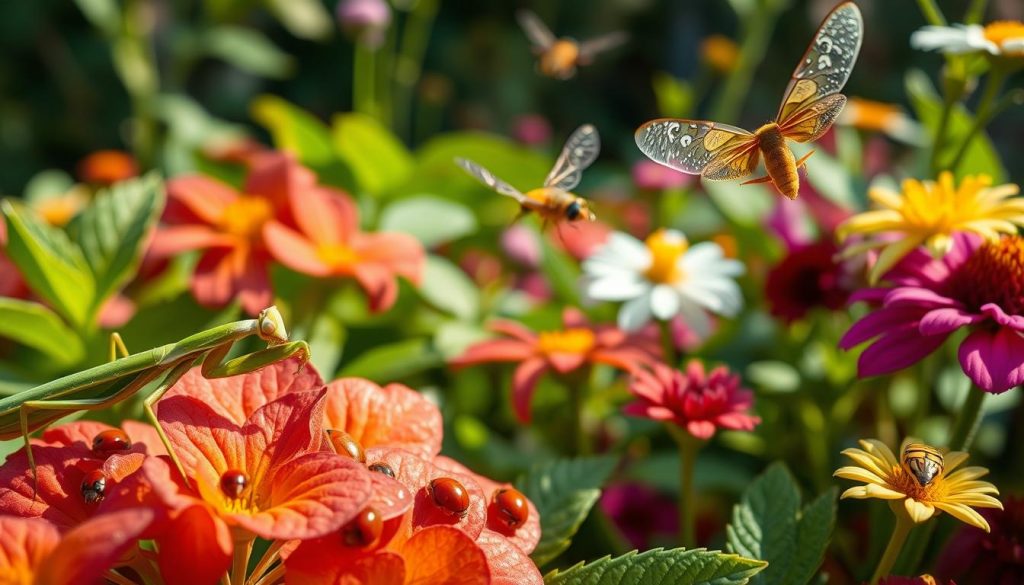
Microbial Solutions for Disease Management
Microscopic organisms protect crops safely. Bacillus thuringiensis (Bt) kills caterpillars and beetle larvae but not good bugs. It’s a safe soil bacterium.
Beneficial fungi like Beauveria bassiana kill pests by growing inside them. Trichoderma species protect roots from diseases, stopping wilting and root rot.
Creating Balanced Ecosystems in Your Yard
A diverse yard fights pests better. Planting different species helps beneficial bugs control pests. Native plants are best because they need less care.
Companion Planting Strategies
Planting certain plants together can keep pests away. Marigolds keep nematodes from tomatoes, and nasturtiums draw aphids away. Basil near tomatoes repels hornworms and flies.
Attracting Natural Predators
Make your yard welcoming to pest fighters. Build insect hotels for bees and wasps, or bird baths for birds. Plants like yarrow and dill attract beneficial insects and predators.
Using biological control means you’re not just fighting pests. You’re making your environment healthier and more balanced.
Physical and Mechanical Pest Control Techniques
Homeowners looking for non-chemical pest solutions have many options. These methods are key to keeping pests away and are safe for families and pets. They offer quick results without leaving chemical residues behind.
Effective Trapping and Exclusion Methods
Trapping is a direct way to tackle pest problems. For rodents, snap traps or humane live-capture traps work well. Place them along walls and paths to quickly reduce pest numbers. Specialized traps, like sticky traps for insects, also help.
Exclusion methods stop pests before they get in. Sealing cracks and holes with materials like caulk and steel wool blocks their entry. Tools like door sweeps and weather stripping are also crucial.
Temperature-Based Treatments
Extreme temperatures can kill many pests. Heat treatments can get rid of bed bugs by raising room temperatures. This method reaches deep into furniture and walls where pests hide.
Freezing can also work for some pests. Freezing items for a few days can kill pests like clothes moths without harming the items.
Barriers and Deterrents for Common Pests
Physical barriers protect your home from pests. These barriers range from simple to complex but all keep pests out. They ensure your living space remains pest-free.
Window and Door Protection
Windows and doors are common entry points for pests. Installing screens with the right mesh size keeps insects out while allowing air to flow. Door sweeps and weather stripping seal gaps when doors and windows are shut.
Foundation and Attic Safeguards
Foundation and attic areas are vulnerable to pest entry. Use fine mesh screens over vents to block pests while allowing air to circulate. Seal utility openings with foam or copper mesh to keep rodents and insects out.
Using these physical and mechanical controls creates a strong defense against pests. These methods are essential for sustainable pest control, protecting your family and the environment.
Year-Round Pest and Disease Control Calendar
Having a pest control calendar is key to keeping your home safe all year. Knowing when pests come out helps you protect your family and property. This way, you avoid the hassle and cost of dealing with big infestations.
Spring: Preventing the Season’s First Invaders
Spring brings warmer weather and pests back to life. It’s time to check your home’s foundation for cracks. This stops ants and termites from getting in.
Look out for termite swarms on warm, rainy days. Use treatments around your home’s base to keep pests out. Also, make sure your garden and lawn have good drainage to prevent fungal diseases.
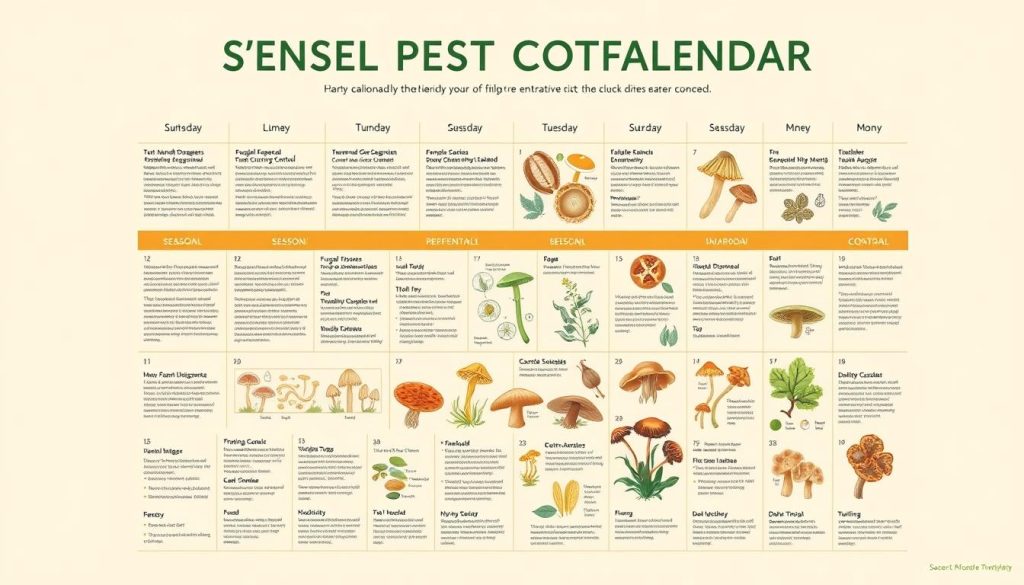
Summer: Managing Peak Pest Activity
Summer is when mosquitoes, flies, and wasps are most active. Get rid of standing water to stop mosquitoes from breeding. Use fans and natural repellents like citronella at outdoor events.
Watch your garden for pests that might come inside. Before you go on vacation, clean up and set traps. Summer is also a good time to protect your wooden structures from pests and diseases.
Fall: Preparing for Overwintering Pests
As it gets colder, pests like stink bugs and rodents look for a warm place to stay. Seal up any gaps and install door sweeps. Clean your gutters to prevent water damage that pests like.
Keeping your yard clean in the fall helps prevent pests. Remove leaf piles and trim branches that touch your house. Store firewood far away. Clear dead plants to stop pests and diseases from spreading.
Winter: Indoor Pest Management Strategies
Winter makes your home a cozy spot for pests. Keep food in sealed containers and check for pests. Use traps in places like basements and attics to catch rodents.
Managing moisture indoors is important in winter. Fix leaks and use dehumidifiers in damp spots. This stops pests like cockroaches and silverfish. Winter is also a good time to plan your pest management for the next growing season.
Tackling Specific Pest Challenges in American Homes
Many pests, like rodents and insects, can damage American homes. General prevention helps, but some pests need special tactics. Knowing these pests and their weaknesses helps homeowners protect their homes.
Rodent Control: Mice, Rats, and Squirrels
Rodents are more than a nuisance; they’re a health and property risk. Start by sealing all entry points, even small ones. Remove food sources by storing items in sealed containers and cleaning up crumbs quickly.
Trapping is a key method for controlling rodents. Use snap traps along walls where rodents travel, baited with peanut butter or dried fruit. For squirrels, use chimney caps and tree trimming to block access.
Persistent Insect Infestations
Bed Bug Elimination Strategies
Bed bugs are hard to get rid of. Look for them often in mattress seams, headboards, and furniture crevices. If you find them, wash and dry bedding on high heat right away.
For treatment, vacuum well and use mattress encasements. Heat treatments are often the best solution, raising room temperatures to kill bed bugs.
Cockroach Management Techniques
To control cockroaches, keep your home clean. Wash dishes fast, store food in sealed containers, and empty trash often. Declutter and seal cracks in walls and floors to reduce hiding spots.
Gel baits work well for German cockroaches, while American cockroaches respond to bait stations near water. Use sticky traps to monitor infestations and check treatment success.
Wood-Destroying Organisms
Termite Prevention and Treatment
Termites cause a lot of damage each year. Start by removing wood from soil contact and fixing moisture issues. Regular inspections by professionals can catch infestations early.
There are several treatments for termites, including soil treatments, bait systems, and wood treatments. The best plans use a mix of methods based on your situation and the termite type.
Carpenter Ant Management
Carpenter ants don’t eat wood but dig into it for nests. Look for frass (sawdust-like material) near wood as a sign of infestation. Fix moisture problems and trim tree branches touching your home to prevent these pests.
To manage carpenter ants, find and treat the parent colony, often in dead trees or stumps. Keeping weeds away from your foundation also helps prevent infestations.
Professional Pest and Disease Control Services
Knowing when to call in the experts can save you time and money. While many can handle minor pest issues, some problems need special skills and tools. It’s important to know when to ask for help for effective pest management.
When to Call in the Experts
Not every pest problem needs a professional. But, if pests are everywhere, you’ll need a detailed plan. This is when it’s time to call the experts.
Termites or carpenter ants can damage your home badly. They need quick action that DIY methods can’t provide. Also, pests like bed bugs or spiders that can harm your health need professional help.
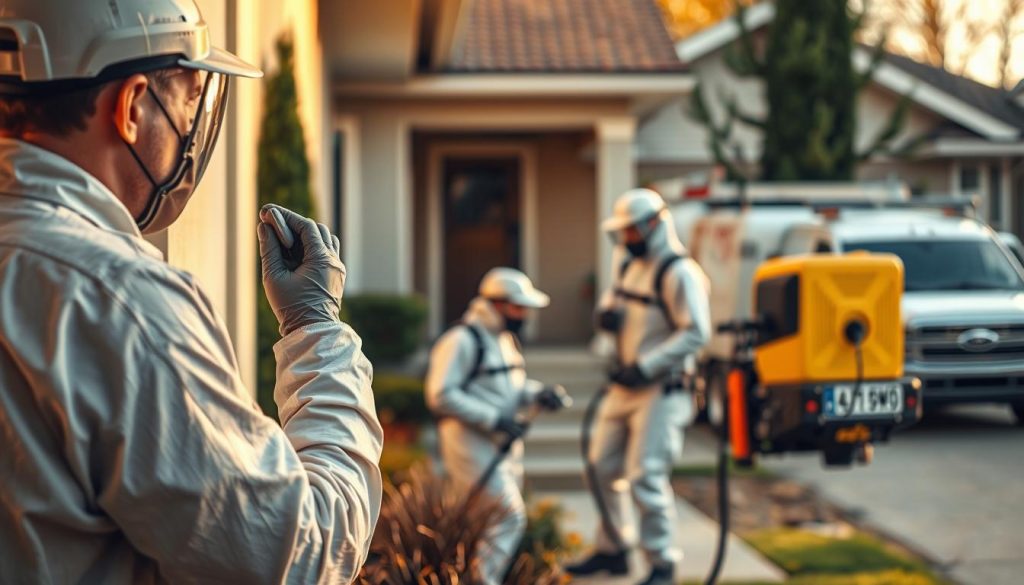
Selecting a Qualified and Reputable Service
Choosing the cheapest pest control isn’t always best. Look for companies with the right licenses and insurance. They should also be members of groups like the National Pest Management Association.
Make sure the technicians are trained in safe pest control methods. Check online reviews and ask friends for recommendations. This helps you find a reliable service.
Questions to Ask Before Hiring
Before you hire, ask lots of questions. Make a list of things you want to know about their methods and safety. This ensures they meet your needs.
| Category | Questions to Ask | Why It Matters | Red Flags |
|---|---|---|---|
| Treatment Methods | What integrated pest management strategies do you use? | Ensures comprehensive approach beyond chemicals | Reliance on spraying chemicals only |
| Safety | How do you protect children, pets, and sensitive individuals? | Addresses family safety concerns | Vague answers about chemical safety |
| Credentials | Can you provide proof of licensing and insurance? | Verifies legal compliance and protection | Reluctance to show documentation |
| Guarantees | What warranty or follow-up services do you provide? | Clarifies ongoing support expectations | No written guarantees offered |
Preparing Your Home for Professional Treatment
Make your home ready for pest control by removing clutter. Clean all surfaces, like kitchens and bathrooms, to get rid of food that pests like. This helps the treatment work better.
Keep pets safe and cover important items. Most companies will give you a checklist to follow. Following their advice after treatment is key for lasting results.
Good pest control uses safe methods, not just chemicals. This way, you get better results and protect your family and the environment.
Building a Healthier Future Through Sustainable Pest Management
The choices we make today shape tomorrow’s world. By choosing sustainable pest management, we protect our families and the environment. This way, we ensure a better future for all.
Now, homeowners have access to powerful tools for pest control. Beneficial insects, nematodes, and microbes help manage pests without harming the environment. These methods are similar to those used in sustainable farming, aiming for balance, not complete elimination.
Climate change is changing pest patterns in America. Warmer winters let insects thrive in new areas. Changes in rain create perfect conditions for disease-carrying pests. We need flexible pest management strategies to adapt to these changes.
Choosing targeted treatments over broad chemicals helps protect beneficial insects in your yard. Sealing entry points instead of spraying reduces chemical exposure and solves the problem at its source.
The future of pest control is about working with nature, not against it. By using integrated methods that include prevention and careful intervention, we make homes and communities healthier. Your choices in pest management impact not just your home but our shared environment.

